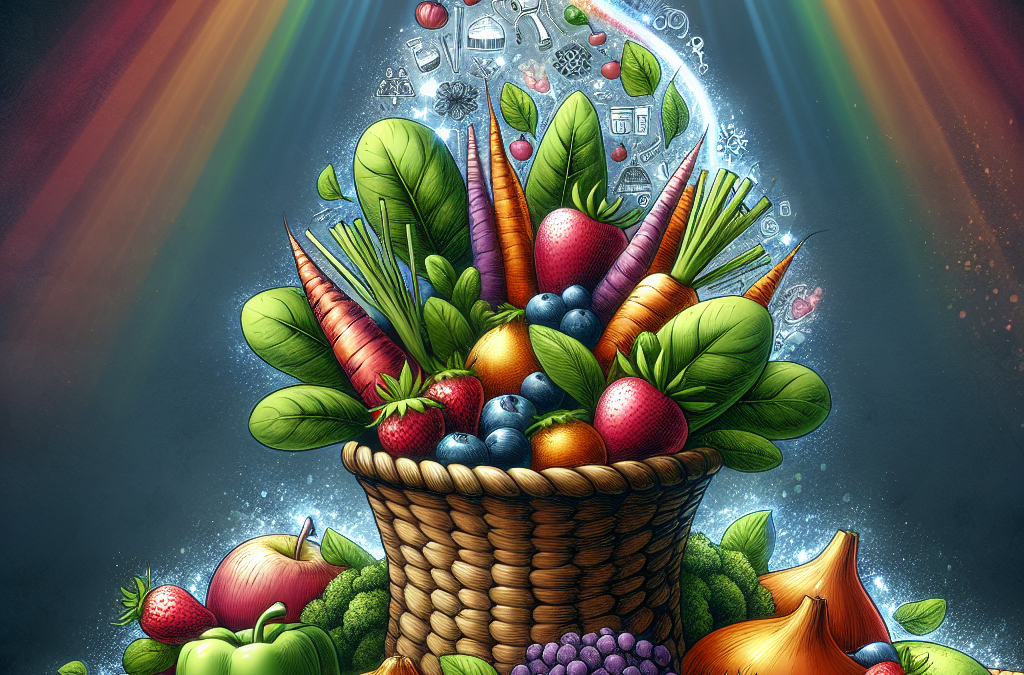- Introduction
- Understanding the Benefits of Fresh Produce
- Top Tips for Incorporating Fresh Produce into Your Diet in 2025
- Maximizing the Nutritional Value of Your Fresh Produce
- Frequently Asked Questions about the Fresh Produce Health Guide
- Conclusion
Introduction
Welcome to the ultimate 2025 fresh produce health guide! In today’s health-conscious world, knowing how to make the most of fresh fruits and vegetables is more important than ever. This fresh produce health guide aims to provide you with practical tips and insights to boost your well-being through quality nutrition.
Whether you’re a seasoned health enthusiast or just starting your journey, understanding the significance of fresh produce can dramatically improve your overall health. As we progress into 2025, staying informed about the latest trends and benefits in fresh produce is essential for maintaining a balanced diet. Let’s explore how you can optimize your intake for peak vitality.
Understanding the Benefits of Fresh Produce
Rich Source of Essential Nutrients
Fresh produce is packed with vital vitamins, minerals, and antioxidants that support overall health. For example, leafy greens like spinach and kale provide iron and calcium, crucial for bone strength and blood health. Consuming a variety of colors and types ensures you get a wide range of nutrients.
Incorporating fresh fruits and vegetables into your diet in 2025 aligns perfectly with current health guidelines. It helps prevent chronic diseases like heart disease, diabetes, and certain cancers. The fresh produce health guide emphasizes diverse intake to optimize nutrient diversity.
Supports Immune System Function
The antioxidants found in fresh produce, such as vitamin C in citrus fruits and berries, bolster your immune defenses. During 2025, maintaining a strong immune system is more critical than ever, especially with ongoing health concerns. Regularly consuming fresh produce can significantly boost your immunity.
Including colorful vegetables like bell peppers, carrots, and sweet potatoes can provide a powerful immune-boosting effect. The fresh produce health guide encourages mindful selection to maximize immune support. Remember, a healthy immune system starts with good nutrition.
Enhances Digestive Health
Dietary fiber from fresh produce such as apples, broccoli, and carrots aids digestion and promotes gut health. A high-fiber diet is associated with reduced risk of digestive disorders and improved nutrient absorption. The fresh produce health guide highlights fiber as a key component of healthy eating.
In 2025, more people are focusing on gut health, and fresh produce plays a vital role in that pursuit. Incorporate a variety of fiber-rich fruits and vegetables daily to support digestive wellness. Staying consistent with your intake helps foster a balanced microbiome.
Promotes Longevity and Anti-Aging
The antioxidants and phytochemicals in fresh produce help combat oxidative stress, promoting longevity and a youthful appearance. Foods like berries, tomatoes, and avocados are known for their anti-aging properties. Following the fresh produce health guide can help you maintain vitality over the years.
As we look toward 2025, prioritizing fresh produce in your diet can contribute to a more vibrant, energetic life. Regular consumption supports cellular health and reduces signs of aging. Embracing fresh produce as part of your routine is an investment in your future well-being.
Top Tips for Incorporating Fresh Produce into Your Diet in 2025
Plan Your Meals Ahead
Planning meals in advance makes it easier to include a variety of fresh produce daily. Create weekly shopping lists featuring seasonal fruits and vegetables to ensure freshness and cost-effectiveness. Using the fresh produce health guide as a resource helps you design balanced and colorful menus.
Meal prepping can also save time and reduce food waste. For example, chop vegetables in bulk and store them for quick use throughout the week. This approach keeps healthy options readily available, encouraging consistent healthy eating habits.
Shop Seasonally and Locally
Buying seasonal and locally sourced produce ensures maximum flavor and nutrient retention. Plus, it supports local farmers and reduces your carbon footprint. In 2025, more markets and farm-to-table initiatives make accessing fresh, local produce easier than ever.
Make it a habit to visit farmers’ markets or join a community-supported agriculture (CSA) program. Incorporating fresh, local produce into your diet aligns with the principles outlined in the fresh produce health guide. Fresh, seasonal foods are a cornerstone of a vibrant, healthy diet.
Experiment with New Recipes
Trying new dishes keeps mealtime exciting and encourages diverse intake of fresh produce. Use cookbooks, blogs, or cooking apps to discover innovative ways to prepare vegetables and fruits. In 2025, taking culinary risks can lead to discovering new favorites that boost your health.
From salads and smoothies to roasted vegetable medleys, variety is key. Incorporating fresh produce in different forms helps you enjoy a range of nutrients and flavors. The fresh produce health guide advocates exploring new recipes to maintain motivation in healthy eating.
Use Prep and Storage Techniques
Proper washing, peeling, and storing techniques help preserve the quality and nutrients of your produce. Store perishable items like berries and leafy greens in breathable containers to extend freshness. Learning these methods supports a sustainable, healthy lifestyle.
Huge Discount on the Best Certified Organic Whole Food Supplement!
Freezing surplus fruits and vegetables is also an effective way to minimize waste and ensure availability year-round. Keeping your produce fresh and accessible encourages regular consumption. The fresh produce health guide emphasizes storage best practices for maximum nutritional benefit.
Maximizing the Nutritional Value of Your Fresh Produce
Choose Organic When Possible
Organic produce often contains fewer pesticides and chemicals, which can negatively impact health. In 2025, consumers are increasingly seeking certification and trusted sources for organic options. Prioritizing organic items can help you adhere to the principles outlined in the fresh produce health guide.
While organic may be more expensive, selecting key items like berries, leafy greens, and root vegetables can maximize health benefits. Washing thoroughly also removes residues when organic options aren’t available. Incorporating organic produce is a proactive choice toward better health.
Combine Produce for Better Absorption
Pairing certain foods enhances nutrient absorption. For example, adding healthy fats like avocados or nuts to your salads boosts the absorption of fat-soluble vitamins such as A, D, E, and K. This approach aligns with the *fresh produce health guide*’s emphasis on nutrient synergy.
Experiment with combining tomatoes with olive oil or carrots with hummus to get the most out of your produce. Small dietary tweaks can significantly enhance your nutrient uptake and overall health in 2025. Embracing these strategies turns simple meals into powerful health supports.
Cook Lightly or Enjoy Raw
Cooking methods affect nutrient retention, with steaming, roasting, or grilling often preserving more vitamins than boiling. Eating certain produce raw, like berries and bell peppers, ensures maximum vitamin intake. The fresh produce health guide recommends variety in preparation for balanced nutrition.
Incorporate raw salads, smoothies, or lightly cooked vegetables into your meals. This diversity keeps your diet interesting and nutrient-dense. By being mindful of cooking techniques, you optimize your health benefits in 2025.
Complement with Supplements if Needed
While fresh produce should be the foundation of your diet, supplements can fill nutritional gaps when necessary. Consult with a healthcare provider or nutritionist to determine if you need additional vitamins or minerals. The fresh produce health guide advocates a balanced approach to nutrition.
Carefully selecting high-quality supplements can support your ongoing health journey. Remember, supplements are designed to complement, not replace, a diet rich in fresh produce. Staying informed helps you make smart choices for your well-being.
Frequently Asked Questions
What is the best way to start implementing the fresh produce health guide in 2025?
Begin by assessing your current eating habits and setting achievable goals to include more fresh fruits and vegetables daily. Planning meals, shopping seasonally, and trying new recipes can make the transition enjoyable. The key is consistency and curiosity about new produce options.
How can I ensure I get enough nutrients from fresh produce?
Incorporate a variety of colorful fruits and vegetables to cover a broad spectrum of nutrients. Eating raw, lightly cooked, or blended into smoothies preserves vitamins and antioxidants. Following the fresh produce health guide helps you build balanced, nutrient-dense meals.
Are frozen or canned produce a good alternative?
Yes, frozen and canned produce can be nutritious options, especially when fresh produce is out of season. Just look for options without added sugars, salt, or preservatives. They are convenient and can help maintain a healthy diet throughout the year.
How does local sourcing enhance the benefits of fresh produce?
Local sourcing ensures produce is fresher, often more flavorful, and retains higher nutrient levels. Supporting local farmers also reduces environmental impact and boosts local economies. In 2025, more resources are available to help you find fresh, local options easily.
fresh whole foods to eat
Conclusion
Embracing the principles outlined in this fresh produce health guide for 2025 is a powerful step toward enhancing your overall well-being. By choosing a variety of seasonal, organic, and locally sourced fruits and vegetables, you can maximize your nutrient intake and support a healthier lifestyle. Remember, small, consistent changes make a big difference; let this guide serve as your roadmap to vibrant health in the year ahead.
Huge Discount on the Best Certified Organic Whole Food Supplement!
Find out more information about “fresh produce health guide”
Search for more resources and information:




